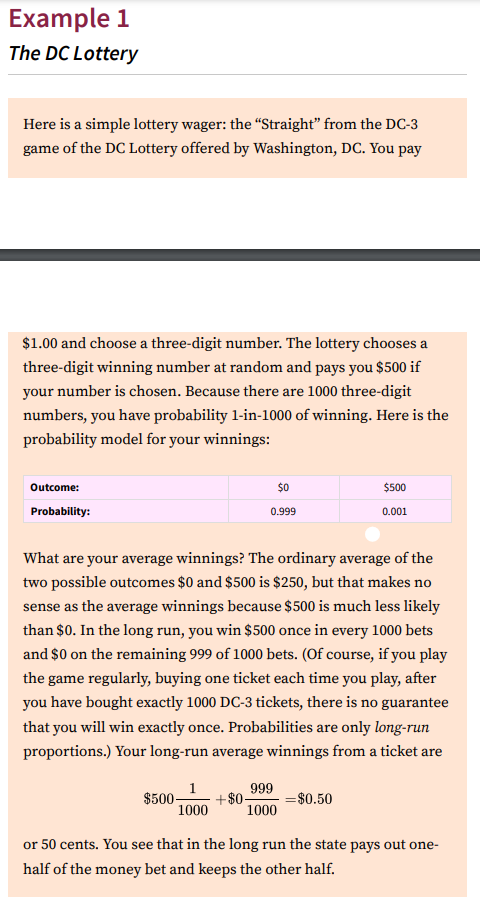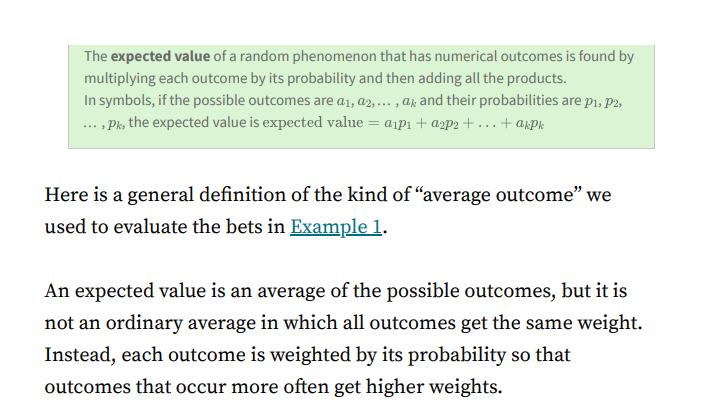The numbers racket. Pick 3 lotteries (Example 1) copy the numbers racket, an illegal gambling operation common in the poorer areas of large cities. States usually justify their lotteries by donating a portion of the proceeds to education. One version of a numbers racket operation works as follows. You choose any one of the 1000 threedigit numbers 000 to 999 and pay your local numbers runner $1 to enter your bet. Each day, one three-digit number is chosen at random and pays off $600. What is the expected value of a bet on the numbers? Is the numbers racket more or less favorable to gamblers than the Pick 3 game in Example 1?
The numbers racket. Pick 3 lotteries (Example 1) copy the numbers racket, an illegal gambling operation common in the poorer areas of large cities. States usually justify their lotteries by donating a portion of the proceeds to education. One version of a numbers racket operation works as follows. You choose any one of the 1000 threedigit numbers 000 to 999 and pay your local numbers runner $1 to enter your bet. Each day, one three-digit number is chosen at random and pays off $600. What is the expected value of a bet on the numbers? Is the numbers racket more or less favorable to gamblers than the Pick 3 game in Example 1?
Chapter8: Sequences, Series,and Probability
Section8.7: Probability
Problem 61E: Roulette American roulette is a game in which a wheel turns on a spindle and is divided into 38...
Related questions
Topic Video
Question
20.8
The numbers racket. Pick 3 lotteries (Example 1) copy the numbers racket, an illegal gambling operation common in the poorer areas of large cities. States usually justify their lotteries by donating a portion of the proceeds to education. One version of a numbers racket operation works as follows. You choose any one of the 1000 threedigit numbers 000 to 999 and pay your local numbers runner $1 to enter your bet.
Each day, one three-digit number is chosen at random and pays off $600. What is the

Transcribed Image Text:Example 1
The DC Lottery
Here is a simple lottery wager: the "Straight" from the DC-3
game of the DC Lottery offered by Washington, DC. You pay
$1.00 and choose a three-digit number. The lottery chooses a
three-digit winning number at random and pays you $500 if
your number is chosen. Because there are 1000 three-digit
numbers, you have probability 1-in-1000 of winning. Here is the
probability model for your winnings:
Outcome:
$0
$500
Probability:
0.999
0.001
What are your average winnings? The ordinary average of the
two possible outcomes $0 and $500 is $250, but that makes no
sense as the average winnings because $500 is much less likely
than $0. In the long run, you win $500 once in every 1000 bets
and $0 on the remaining 999 of 1000 bets. (Of course, if you play
the game regularly, buying one ticket each time you play, after
you have bought exactly 1000 DC-3 tickets, there is no guarantee
that you will win exactly once. Probabilities are only long-run
proportions.) Your long-run average winnings from a ticket are
1
$500-
+$0-
1000
999
=$0.50
1000
or 50 cents. You see that in the long run the state pays out one-
half of the money bet and keeps the other half.

Transcribed Image Text:The expected value of a random phenomenon that has numerical outcomes is found by
multiplying each outcome by its probability and then adding all the products.
In symbols, if the possible outcomes are a1, a2,... , a; and their probabilities are pı, P2,
... , Pk, the expected value is expected value = aip1 + a2P2 + ...+ a,pk
Here is a general definition of the kind of "average outcome" we
used to evaluate the bets in Example 1.
An expected value is an average of the possible outcomes, but it is
not an ordinary average in which all outcomes get the same weight.
Instead, each outcome is weighted by its probability so that
outcomes that occur more often get higher weights.
Expert Solution
This question has been solved!
Explore an expertly crafted, step-by-step solution for a thorough understanding of key concepts.
This is a popular solution!
Trending now
This is a popular solution!
Step by step
Solved in 2 steps

Knowledge Booster
Learn more about
Need a deep-dive on the concept behind this application? Look no further. Learn more about this topic, statistics and related others by exploring similar questions and additional content below.Recommended textbooks for you

